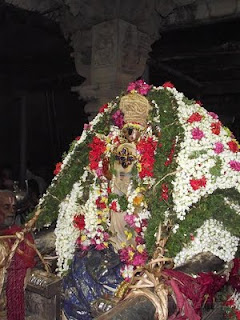Continued From: http://thoughtsonsanathanadharma.blogspot.ca/2013/05/srimadh-bagawatham-curse-of-jaya-and.html
 |
| Nithya Kalyana Perumal |
Lord
Brahma instructed Swayambhuva Manu to live on Earth and create life forms on
earth. As Swayambhuva Manu looked in the direction of Earth, he noticed that
Earth was not present. He complained to Lord Brahma. Lord Brahma found out that
Hiranyakshan had hid Earth under the deluge waters. Lord Brahma meditated upon
Lord Vishnu.
Since
Earth is responsible for the quality of smell and smell is perceived with the
help of nose Lord Varaha appeared from the nostril of Lord Brahma as the
purpose of His incarnation is to help find Earth. He appeared in the form of a
small boar and within a few seconds turned into a large form. He was so large
that He was larger even than Trivikrama!
Lord
Varaha killed Hiranyakashipu and brought the submerged Earth above the deluge
waters.
Bhumi
Devi was very pleased with Lord Varaha as He had rescued the object for which
she is the deity. Thus she appeared on top of the Earth and she was supported
by Lord Varaha on His divine shoulders. The Lord supported Bhumi Devi on
His shoulders and placed one hand to support her feet to show us that we must
first do prapatti at her feet and reach the Lord through her.
Goddess
Bhumi Devi was very happy that Lord Varaha rescued Earth but she also requested
Him to save all the creatures that would be created on Earth. She felt worried that the creatures
influenced by their past karmas would take birth and experience the “tapa
trayam”.
The three types of tapa trayam are
1.
Adhyadhmikam:
Sufferings experienced by us because of our association with people, work,
society etc. These problems are created because of our interaction with others.
2.
Adhiboudhikam:
Sufferings which are beyond our control like troubles we face due to pest
damage, pathogens etc.
3.
Adhideivikam:
Sufferings caused by natural calamities like storms and Earthquakes.
She
requested the Lord to show us the way to escape the three types of tapa trayam.
She knew that the three troubles could be escaped only when we reach Sri
Vaikuntham. Therefore she asked the Lord to tell her about the way by which
every single jeevatma can escape Samsara.
Lord Varaha's Instructions to Esacpe Samsara:
The Lord
mentioned that by singing His praise we can escape Samsara. For every letter in
the song, the Lord grants us one thousand years in heaven. Even when the
jeevatma is in heaven, the jeevatma will continue to sing the praise of the
Lord and is not distracted by heavenly pleasures. This jeevatma is saluted by
Devendra every single day. After the jeevatma’s time in heaven, it is
automatically elevated to Sri Vaikuntham.
The
second method is by offering beautiful flower garlands to the Lord. Only fragrant flowers are to be offered to
our Lord. Fragrance represents pleasant smell and is therefore a symbol of
Goddess Bhumi Devi as well.
 |
| Nam Perumal - Poo Sathi Utsavam srirangarajan.blogspot.com |
Goddess
Bhumi Devi gives us everything we need to worship the Lord. She gives us
fruits, flowers, incense, sandal and so on. She wanted to demonstrate the
proper way to worship Lord Vishnu. She made a note of the Lord’s instruction
and waited for 27 chatur yugams to pass by before incarnating as Andal.
 |
| Andal Nachiar |
She
chose the time of her incarnation carefully as she wanted to incarnate as the
daughter of Periazhwar. She gave us the Thirupavai Pasurams which are the
musical garland while also showing us how to worship the Lord with flower
garlands.
 | |
| Lord Srinivasa Thomala Seva. |










